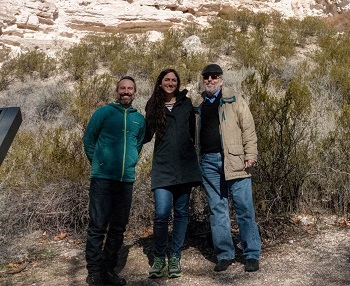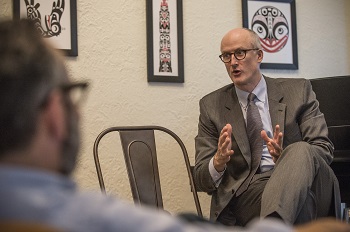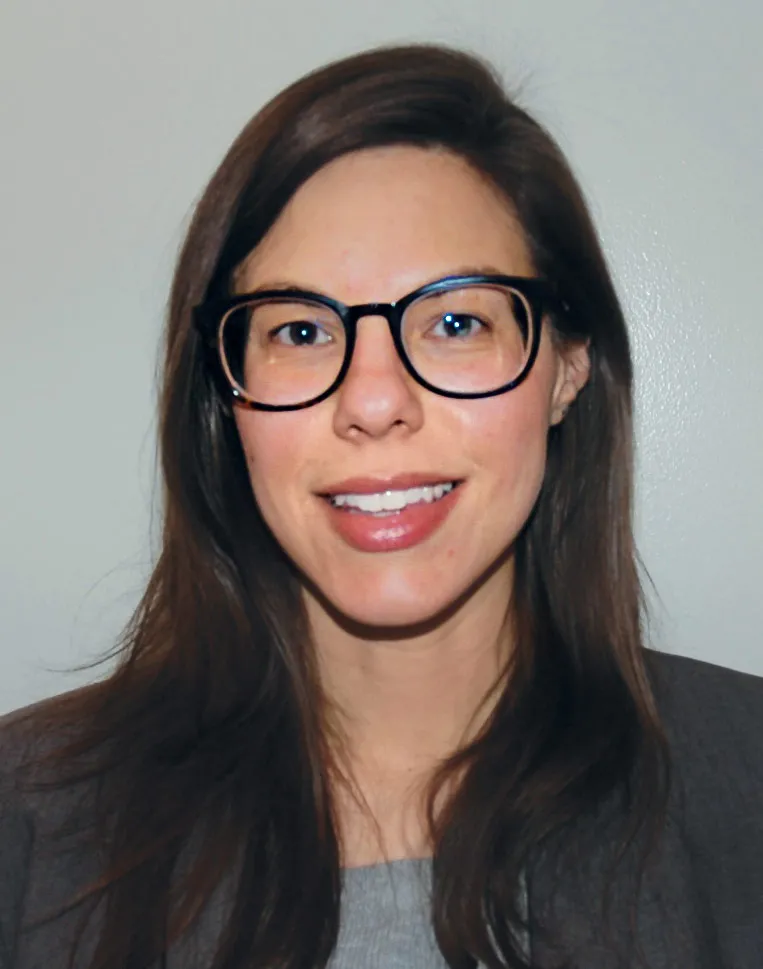Exploring Tribal Justice: The Law School’s First Experiential Program in Native American Law Lets Students Clerk for the Hopi Appellate Court

Charlie Baser, ’16, had considered becoming a photojournalist.
But on a college assignment, she began visiting the Blackfeet Indian Reservation—and there, in northern Montana on the edge of Glacier National Park, she saw the ways in which history, culture, and a tangle of tribal, state, and federal laws can give rise to complicated disputes that sometimes echo an equally complicated past. There were questions of tribal sovereignty and jurisdiction, tussles between ancient tradition and modern American legal norms, and a visible connection between the courts and the daily lives of people on the reservation. Native American culture had illuminated the intricate threads binding law and society, and that was it—Baser knew she wanted to become a lawyer.
What she didn’t expect when she headed off to the University of Chicago Law School, though, was that she’d have a chance to learn the law by working to unknot some of very questions that had drawn her in. In early 2016, Todd Henderson, the Michael J. Marks Professor of Law, and Justin Richland, a UChicago anthropology professor with an expertise in Native American law and politics, offered her a rare opportunity: to work as a student clerk on the Hopi Appellate Court in Arizona—and help pilot the Law School’s first experiential program in American Indian Law.
“This is an area of law that is intellectually fascinating but also deeply important,” Baser said. “There are these really interesting, thorny questions that haven’t been fully, or at least satisfactorily, settled but can have a real impact on people’s lives. I also love the way history uniquely plays into Indian law—it’s all based on treaties that were drawn up at the founding of the country. This ended up being one of the best experiences of my law school career.”
 This fall, Henderson and Richland, a Law School lecturer and an associate justice on the Hopi Appellate Court, officially launched the Hopi Law Practicum, which blends classroom instruction with cultural exposure and real-world experience. Participants take American Indian Law, a course co-taught by Henderson and Richland, and serve as law clerks on the Hopi Appellate Court doing legal research, writing bench memoranda, and drafting opinions on live cases. Although all of their coursework and most of their casework will be done in Chicago, the five students enrolled in the 2016-17 practicum will make at least one visit to Hopi, where they will attend oral arguments, present findings to Hopi tribal officials, and participate in judicial deliberations.
This fall, Henderson and Richland, a Law School lecturer and an associate justice on the Hopi Appellate Court, officially launched the Hopi Law Practicum, which blends classroom instruction with cultural exposure and real-world experience. Participants take American Indian Law, a course co-taught by Henderson and Richland, and serve as law clerks on the Hopi Appellate Court doing legal research, writing bench memoranda, and drafting opinions on live cases. Although all of their coursework and most of their casework will be done in Chicago, the five students enrolled in the 2016-17 practicum will make at least one visit to Hopi, where they will attend oral arguments, present findings to Hopi tribal officials, and participate in judicial deliberations.
“The practicum is an opportunity to broaden one’s horizons about the world by interacting with people who are approaching familiar legal problems—creating a good society, conducting your behavior in a way that comports with rules—but in a completely different cultural context,” Henderson said. “Even if you don't work on Indian law issues after law school, the opportunity to be a law clerk for an actual judge on active cases during law school is a singular experience. But, boy, I do hope some of these students pursue this area. There are huge issues about natural resources, water, gaming—and many of these are going to grow in importance.”
It’s also an opportunity the benefits both the students and the court, said Robert N. Clinton, ’71, Chief Justice of the Hopi Appellate Court.
“It’s a fairly unique learning opportunity, and it’s something I didn’t have in law school in the 1960s," he said. "This is a chance for students to become familiar with tribal government—they see that tribes have laws and functioning courts, and they learn how to do legal research with respect to the tribal courts. And obviously having law clerks is useful for any judge—it gives us the opportunity to bounce ideas off of some young minds. The clerks are utterly invaluable in putting in those tedious hours in spotting things in the record that, given the pressures of our docket, we might otherwise miss.”
In many ways, the story of the Hopi Law Practicum and how it came to be is one of converging interests, good timing, and the kind of intellectual curiosity that powers Law School life. Henderson typically focuses on securities regulation and law and economics but developed an interest in Indian law that was sparked, in part, by his experience living near Hopi in 2001 while his wife was completing a medical residency with Indian Health Service. (Note: “Hopi” can refer to the language, the people, and the geographic location of the tribe.) Henderson was drawn to the “amazingly warm and fascinating society” and intrigued by the ways it differed from other parts of America. But he didn’t begin writing about it until a few years ago, when a Law School alumnus who works on Capitol Hill told Henderson that few scholars were addressing Native American issues with a UChicago-style, big-picture, law-and-economics bent. After that, Henderson wrote several pieces on Native American issues for SCOTUSblog. Then he met Richland—their kids played baseball together—and the two decided to teach a Greenberg Seminar on Native American law. It wasn’t the Law School’s first class on this area of law, but it was the start of a new collaboration.
Richland, on the other hand, had discovered his passion for Native American culture and tribal justice as a law student at Berkeley in the mid-1990s. A fellow student, Patricia Sekaquaptewa, a member of the Hopi tribe and now also a Hopi appellate judge, helped recruit him to the new clerkship program, which had been created, in part, to help relieve a backlog in the relatively nascent and understaffed Hopi tribal court system. Hopi’s court system had been created just a quarter-century earlier, replacing the Code of Federal Regulations (CFR) courts that had been set up by the Bureau of Indian Affairs. Richland was fascinated by the tribal courts, the development of Hopi jurisprudence, and by the way it helped shape their sovereignty as a tribal nation. He eventually earned a PhD in linguistic anthropology, studying the ways Hopi and English languages were being used by litigants, lawyers, and judges to argue claims before the Hopi courts, and came to UChicago in 2011. He was looking for a way to bring the Hopi clerkship program to the Law School when he and Henderson came to know Baser.
For Baser, the timing was serendipitous. She had chosen the Law School for its academic prowess, but knew it was miles from the nearest reservation. She had assumed she’d engage with American Indian law peripherally—and she explored tribal issues for papers in several classes. But then other paths began to open up, too. During her second year, Baser enrolled in the Greenberg Seminar on Native American Law. Later, she launched an independent study project on water law that focused on federal and Indian reserved rights. Associate Clinical Professor Mark Templeton, the Director of the Abrams Environmental Law Clinic, oversaw that project, telling her that if there was something that was new to him he’d “learn right alongside me.” By her third year, Richland and Henderson were developing the practicum.
“I just grabbed on, and I made sure they knew I was deeply interested in being a part of it,” Baser said. Looking back, the different ways in which each player developed an interest in tribal justice made for a richer exploration of ideas, she said. “Ultimately, I probably had a much cooler experience dealing with Indian law than I would have anywhere else.”
 The program fits a broader story of UChicago’s engagement with Native American culture, history, and law. The late Law School Professor Karl Llewelyn co-wrote the first great legal anthropological study of American Indian law called The Cheyenne Way: Conflict and Case Law in Primitive Jurisprudence in 1941. The late UChicago Anthropology Professor Sol Tax, PhD ’35, was an expert in Native American issues who created “action anthropology,” which sought to blend scholarly work with efforts to help the communities he studied. In 1961, Tax helped organize hundreds of American Indian tribal leaders for the week-long American Indian Chicago Conference at the University of Chicago, a gathering that resulted in the Declaration of Indian Purpose and helped mobilize Native American activists.
The program fits a broader story of UChicago’s engagement with Native American culture, history, and law. The late Law School Professor Karl Llewelyn co-wrote the first great legal anthropological study of American Indian law called The Cheyenne Way: Conflict and Case Law in Primitive Jurisprudence in 1941. The late UChicago Anthropology Professor Sol Tax, PhD ’35, was an expert in Native American issues who created “action anthropology,” which sought to blend scholarly work with efforts to help the communities he studied. In 1961, Tax helped organize hundreds of American Indian tribal leaders for the week-long American Indian Chicago Conference at the University of Chicago, a gathering that resulted in the Declaration of Indian Purpose and helped mobilize Native American activists.
The practicum has a natural interdisciplinary bent, combining philosophical and sociological questions with the practice of law. Students consider complex socio-legal issues in a wide range of areas, including constitutionalism, crime and punishment, civil procedure, property, contract, and family law, often exploring the balance between Anglo-American legal structures and longstanding tribal norms and considering the ways in which law and culture intersect on tribal land.
“There are foundational questions in this area of law that are at the heart of what law is and does—and what it means to people whose cultural values far preexist the legal system that is now in place,” Richland said. “Hopi is a community that has a very strong sense of who they are as distinct and unique from the U.S., but is nonetheless integrated into it. For them, these questions are very complex but also incredibly interesting and lively.”
Unknotting Complexity
One afternoon in September, not long before Henderson and Richland held their first meeting with the law students who had enrolled in the practicum, a visitor to Henderson’s office asked how jurisdictional issues are decided on American Indian reservations. Does tribal law always apply? When do state and federal laws come into play?
Henderson grinned and tapped the thick black book on federal Indian law that was sitting on table between them.
“Here you go. Take a read of these 600 pages and then let me know,” he said with a chuckle. “It’s unbelievably complicated.”
Perhaps as a result, tribal citizens are often aware of jurisdictional issues in a way that they aren’t in other places. “People know that if something happens on this part of land, the federal government will be in charge of it, or if it happens here, the tribal government is in charge of it,” Baser said. “It’s a really interesting dynamic, especially in criminal issues.”
Baser remembers poring over Hopi law in a case in which a tribal citizen had waived his right to an attorney. The standards for the right to an attorney were different depending on the controlling jurisdiction and, what’s more, if the waiver had been deemed invalid under Hopi tribal law, it might also have been in violation of the federal Indian Civil Rights Act. In the end, the justices determined that the waiver was valid, but the complexity hammered home for Baser just how difficult it could be to untangle law on a reservation.
And that’s part of what makes the practicum appealing to some students: they want the intellectual challenge and the exposure to new issues.
Sterling Paulson, ’18, enrolled in the practicum this year in part because he has a personal interest in indigenous culture but also for the opportunity to learn about a different jurisdiction that exists alongside state and federal law.
“It’s been fascinating seeing how tribal custom is woven in right next to U.S. constitutional law and state statutes,” said Paulson, whose wife is a member of the Osage Nation. “In tribal court, you’ll see testimony from tribal elders right next to long-accepted common law from England. Indian law is unique in that way, and it’s so interesting to me.”
Hopi, for instance, is a matrilineal society, which means that disputes over property and inheritance are often tied to clan relationships through the female line. An inheritance claim that goes one way in state court might go the other way in Hopi court.
“It’s not just codified statutes that we’re working with—it’s tribal customs and unique history and heritage,” Paulson said. “With anything pertaining to Indian law there are always unique questions that you don’t encounter in other places. So as an outsider, you have to work to build that understanding.”
American Indian law is, of course, a product of the complicated history that created it. Tribes possess a nationhood status and retain inherent powers of self-government, a guiding principle of federal Indian law that was articulated by U.S. Supreme Court Chief Justice John Marshall when the governmental authority of tribes was first challenged in the 1830s. But over the years, various treaties, acts of Congress, executive orders, federal administrative agreements, and court decisions have limited sovereignty. Although tribes participate in decisions about their citizens and property, tribal law doesn’t always apply, particularly when non-tribal actors are involved. And not all tribal courts are the same. Some tribes are still covered by CFR courts, and among those with their own court systems, traditions vary widely. Some, like Hopi, hew closely to the U.S. legal system. Nearly all are relatively young and many are understaffed.
In Hopi, appellate court clerks provide needed support, allowing judges to be more thorough and timely. In recent years, the clerkship program has given judges the space to focus more attention on issues involving tribal custom, and to integrate traditional norms into the common law, said Sekaquaptewa, the Hopi appellate judge who helped create the clerkship program as a law student two decades ago. “It made it so the Hopi community wanted to use their courts,” she said. “It helped instill faith in the system.”
The students, in addition to gaining practical experience, learn how to connect the ideas of a different culture and different legal system to their knowledge of U.S. law.
“It really helps them understand the U.S. system better—and to have more tolerance and respect for other cultures,” Sekaquaptewa said. “There’s something about native judges and students working through these problems together that is extremely rewarding and valuable. You’re not getting outsider do-gooders in and imposing their sense of everything onto a different culture. It’s much more symbiotic—and necessary, too, because the modern world is interconnected.”
Baser can attest to the impact. After she graduated from the Law School last spring, she moved to Santa Fe to work for Holland & Hart in the Energy, Environmental, and Natural Resources practice group. Her work doesn’t focus specifically on American Indian law, but in New Mexico native issues intersect regularly—and she arrived ready for that. Sometimes, when she’s dealing with both federal and New Mexico state law, she hears echoes of the jurisdictional tangles she encountered as Hopi clerk.
She was thrilled to see the clerkship become part of a formal program at the Law School, where it can offer other students the opportunity to explore the cultural, historical, and legal issues that captured her interest.
“The students who go to Hopi and work with the appellate judges will see what an interesting and vibrant culture there is—and how important tribal sovereignty and the existence of tribal courts and the existence of bodies of tribal law are,” she said. “This is a real facet of our legal world that people don’t see when they live far away from major reservations.”




